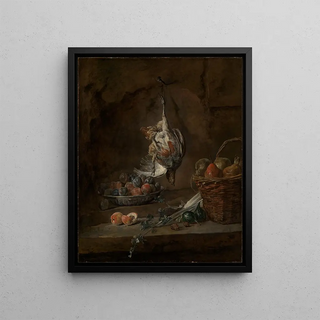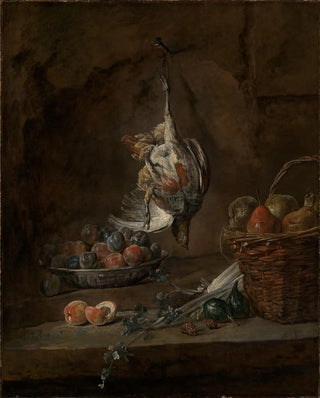Art print | Still life with dead partridge - Jean Siméon Chardin


View from behind

Frame (optional)
Nature morte with dead partridge - Jean Siméon Chardin – Captivating Introduction
The still life, often perceived as a simple assembly of inanimate objects, takes on a profoundly evocative dimension here under the brush of Jean Siméon Chardin. In "Nature morte with dead partridge," the artist manages to transcend the banality of everyday life to offer a reflection on life, death, and the beauty of simple things. This painting, imbued with realism and delicacy, immerses us in a universe where each element, each shade of color, tells a story. By contemplating this work, one is invited to question the relationship between man and nature, as well as to appreciate Chardin's technical mastery, which, through his skill, transforms an ordinary scene into a true visual poem.
Style and uniqueness of the work
The uniqueness of "Nature morte with dead partridge" lies in how Chardin manipulates light and textures. The feathers of the partridge, delicately rendered, seem almost tangible, while the dark background highlights the warm tones of the fruits and vegetables surrounding it. This play of contrasts creates an intimate, almost meditative atmosphere, where the viewer is led to appreciate the ephemeral beauty of life. Chardin does not merely depict objects; he breathes soul and story into them. Each element of the composition, whether it is the partridge, the fruits, or the tableware, is carefully arranged, demonstrating a keen sense of harmony and balance. This approach, typical of Chardin's style, makes this work an emblematic example of the realism movement, where the ordinary is sublimated through the artist's gaze.
The artist and his influence
Jean Siméon Chardin, an emblematic figure of the 18th century, left a mark on art history with his ability to capture the essence of things. Born in 1699 in Paris, he managed, throughout his career, to establish himself as a master of still life, while exploring other genres such as portrait and genre scene. His work is often seen as a counterpoint to the excesses of rococo, focusing on simplicity and truth.

Matte finish

View from behind

Frame (optional)
Nature morte with dead partridge - Jean Siméon Chardin – Captivating Introduction
The still life, often perceived as a simple assembly of inanimate objects, takes on a profoundly evocative dimension here under the brush of Jean Siméon Chardin. In "Nature morte with dead partridge," the artist manages to transcend the banality of everyday life to offer a reflection on life, death, and the beauty of simple things. This painting, imbued with realism and delicacy, immerses us in a universe where each element, each shade of color, tells a story. By contemplating this work, one is invited to question the relationship between man and nature, as well as to appreciate Chardin's technical mastery, which, through his skill, transforms an ordinary scene into a true visual poem.
Style and uniqueness of the work
The uniqueness of "Nature morte with dead partridge" lies in how Chardin manipulates light and textures. The feathers of the partridge, delicately rendered, seem almost tangible, while the dark background highlights the warm tones of the fruits and vegetables surrounding it. This play of contrasts creates an intimate, almost meditative atmosphere, where the viewer is led to appreciate the ephemeral beauty of life. Chardin does not merely depict objects; he breathes soul and story into them. Each element of the composition, whether it is the partridge, the fruits, or the tableware, is carefully arranged, demonstrating a keen sense of harmony and balance. This approach, typical of Chardin's style, makes this work an emblematic example of the realism movement, where the ordinary is sublimated through the artist's gaze.
The artist and his influence
Jean Siméon Chardin, an emblematic figure of the 18th century, left a mark on art history with his ability to capture the essence of things. Born in 1699 in Paris, he managed, throughout his career, to establish himself as a master of still life, while exploring other genres such as portrait and genre scene. His work is often seen as a counterpoint to the excesses of rococo, focusing on simplicity and truth.






